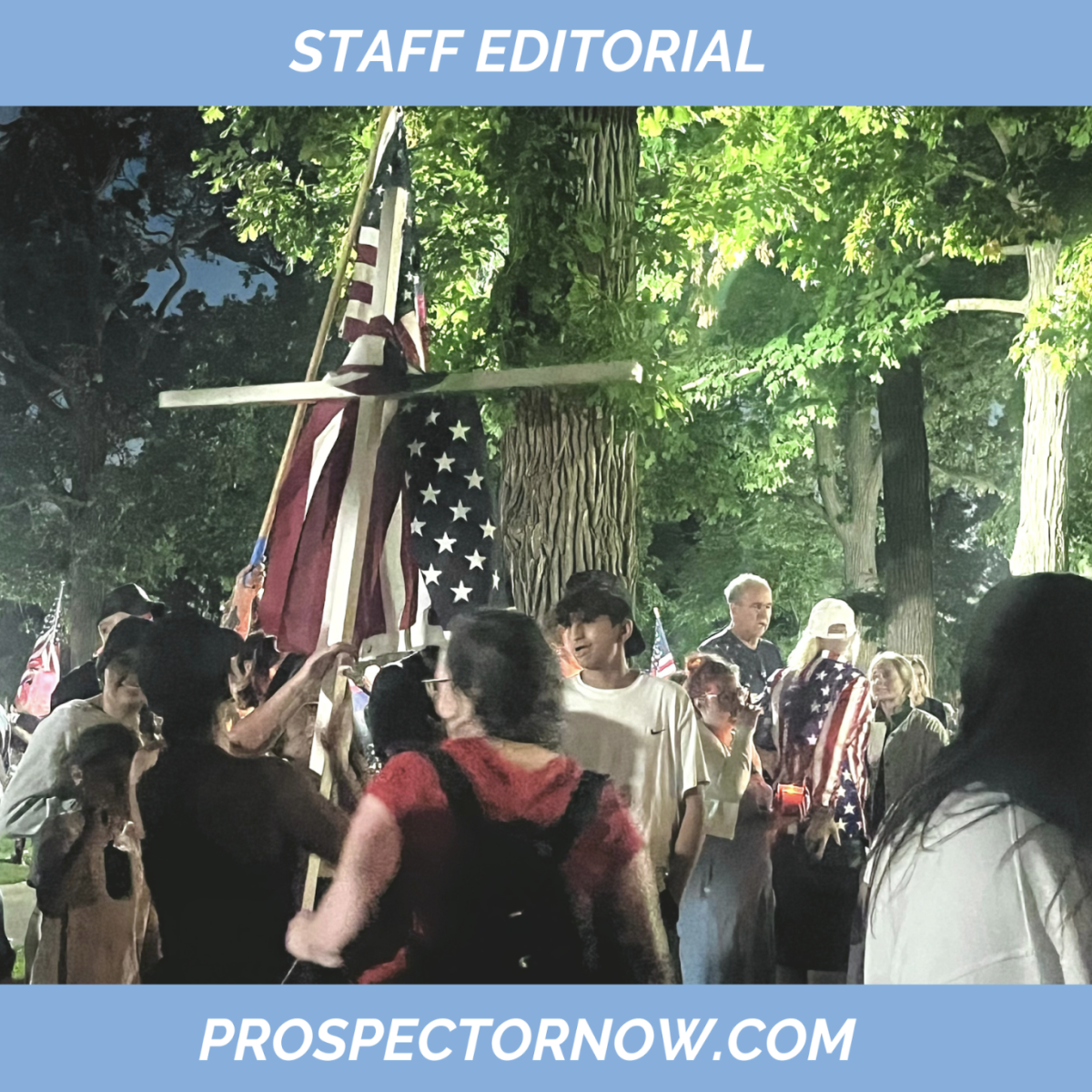By Mike Sebestyen
Social Science Teacher/Guest Columnist
For the students who walk into my classroom on a daily basis, there is an understanding of what is considered appropriate and inappropriate in regards to their everyday attire.
This expectation has led to my reputation amongst the student body as one who is very strict in upholding the ideals of the school dress code.

Here at Prospect, all that is really necessary is a consistent enforcement of the dress code for the creation of a proper learning environment.
That environment is the responsibility of the staff as well as the students here at Prospect. Unfortunately, someone is dropping the ball on this situation, and right now we as a teaching staff are the ones at fault.
First: some background disclosure. I am a product of uniforms, having attended nine years of Catholic grade school and four years of Catholic high school.
My everyday attire when I walked the halls of Fenwick High School consisted of dress pants, dress shirt and tie. In contrast to my education, I have spent the last 12 years at Prospect, where uniforms are not a part of everyday life.
Having a background in both schooling experiences, I feel I offer a unique perspective on the school uniform debate, and it is obvious that the problem is not the lack of a dress code.
If you want to establish a more efficient decorum for the educational experience, all that needs to be done at Prospect is a more consistent enforcement of the current dress code. While I may appreciate the many arguments on behalf of school uniforms, the reality of the situation does not mirror the idealism of these advocates.
One argument made by many is that uniforms will bring a sense of security within the school community. For example, Grace Chen gives details in a 2008 article from Public School Review about how the Long Beach, Calif. school district saw fights and muggings at school decline by 50 percent after one year of uniforms in their schools.
While this is a nice stat to show improvement of security, to say wearing a uniform is the sole reason for decline in violence is imprudent.
A more accurate case study to evaluate this claim comes from David Brunsma and Kerry Rockquemore (1998) called “Effects of Student Uniforms on Attendance, Behavior Problems, Substance Abuse and Academic Achievement.”
This inquiry followed students from eighth grade until the end of college to study the effect of uniforms on their educational experience. What Brunsma and Rockquemore found is that there is NO CORRELATION between uniforms and reduction of violence, substance abuse or attendance in schools.
This study has been the first of many to refute the myth of school security being tied to school uniforms. As stated in an analysis by The Education Pages, no matter the dress (including uniforms), students will always find a way to pass judgment upon their peers.
To stop bullying, the school needs to pay more close attention paid to the conditions of the school, not uniforms. This idea of uniforms bringing security and stopping actions like bullying is unfounded.
An additional argument made by many is that uniforms will bring an improvement in academic achievement within the school community.
Chen’s article elucidates the belief amongst many school administrators and parents that “uniforms create a better learning environment at school…students can focus more upon their schoolwork, rather than social appearances.”
This myth is based on no statistical evidence, just a campaign by some to control the free expression of students. Once again, Brunsma and Rockquemore (1998) prove this argument to be preposterous, as their case study found NO STATISTICAL CORRELATION between academic preparedness being enhanced by the wearing of a uniform.
This study and many others have shown us that uniforms are not going to turn little Andrew from a C student to an A student. Little Andrew dedicating himself to learning the concepts of the material in class will help him improve his grade.
Trust me, I earned my C in Spanish class in high school and my C in Psychology in college, wearing a uniform had no impact.
My penchant for not reading the textbook impacted the grade (which is funny considering I give students a hard time about not reading their textbook for my classes).
In fact, uniforms will harm the learning environment in a public school setting as it harms a student’s need for self-expression and discovery.
Here at Prospect, students are learning about themselves as they enter adulthood. Even Chen’s article admits that denying students their ability to express individualism “could stymie the students’ transition from childhood to adulthood.”
As a school with the given mission to produce young adults ready to contribute to society, the evidence shows uniforms would be a major disservice to our student body.
A different point that uniform advocates try to make is that wearing uniforms will help to diminish the economic and social barriers between students as it will eliminate opportunities for the less popular or less fortunate students to be singled out by attire.
The problems with this argument are two-fold. To begin, uniforms will not end social stratification present at Prospect.
Unless the cars in the parking lot become uniform for all students (and we all know you all want to drive the same Pontiac Sunfire I drive) , and students become required to wear uniforms at all extracurricular events, students are going to figure out the economic and social disparity between members of the student body. Second, the financial burden for parents and students will increase, as the uniform is only for school.
More clothes will still be needed for everyday attire outside of school, which creates a ludicrous cost for all. Students will have to buy multiple pairs of pants and shirts for their uniform, unless you want to be the “smelly kid” (Thank you, Adam Sandler and “Big Daddy”) wearing the same uniform five days a week.
As stated by the author (and Mr. Barr’s hero,) William F. Buckley, Jr., “Idealism is fine, but as it approaches reality, the costs become prohibitive.” I think this cogent thought from Mr. Buckley proves right. The costs of implementation of uniforms for families would create more economic and social problems for all.
Having a very modest financial background growing up, my parents could not afford many pairs of pants and uniform shirts from year to year.
Therefore I had to make uniform pants survive for more than one year. I still to this day can hear the comment, “Hey Seb, where is the flood?” as a way of making fun that I had outgrown the length of my pants. No wonder I am such a reserved and quiet teacher today!
After everything else, the final argument from uniform advocates comes from an article by Marian Wilde in which she rationalizes that some believe uniforms will create discipline in the schools. The belief here is that the uniform will create a condition of conformity and decorum that will provide “military-like discipline” from the student body.
This concept is frankly absurd. As someone who has experienced the “uniform-education structure,” I can certify that uniforms will lead to more violations of dress code, more open and intentional attempts to challenge authority and will not improve discipline but in fact encourage student rebellion.
My experiences at Fenwick saw students every day try to “skirt” (get it…”skirt”…it is a uniform joke) the rules of the dress code, either in the style of tie they wore, the shirt they chose or the length of their hairstyle. At Providence Catholic High School in New Lenox, the female students consistently challenged the dress code by messing with the length of their skirts.
This open rebellion to the uniform eventually led to the decree by their principal, Don Sebestyen (trust me, a man known for his discipline – I still cannot wear a hat in my parents’ house), that the female student uniform would no longer allow skirts for school, only dress pants.
The amount of time that would be taken away from the educational process because of the open war students would declare in this school because of uniforms would be in antithesis to school discipline.
Uniforms are unnecessary in the public school forum. Discipline of dress can be enforced at places like Prospect without going to the extreme of a uniform for students. What uniforms would be is a “band-aid” on the larger problem that demands “stitches.” That larger problem is the lack of enforcement of the dress code.
If the teaching staff at Prospect would make the effort to actively address their shortcomings in the enforcement of dress code, many of the problems we have in regards to student attire and discipline would be solved.
All uniforms would accomplish in this situation is an allowance for staff to continue to shirk responsibility for their job – establishing the proper learning environment for the students here at Prospect.
Students have shown they will follow the rules of their school, and that they will respect those rules and each other.
If a student walks into class with a spaghetti strap top, all it takes is me stating “That is a violation of dress code” for that offending student to put on a sweater or jacket to rectify the situation.
Whether that student wearing the spaghetti strap shirt is Gina O’Neill or John Munz in 2007 (a story that would take a lot longer to explain than this article will allow), it is very easy for students to follow simple enforcement.
A consistent enforcement of established policy is all that is necessary. All uniforms would create is a step backwards in the educational process of the public school mission.
To read columnist Andy Barr’s rebuttal, click here.






Jackie Evancho • Sep 26, 2010 at 2:13 pm
I do like if school have proper dress code. I really like uniforms, and they make people more or less equal and this is good.
Liz Sheehan • May 15, 2010 at 2:46 pm
Good argument! It was nice to see the statistic on how violence and education have nothing to do with the dress code. It’s also true that students will just find a way to pick on each other without clothing. Clothing is barely the issue of bullying today anyway. Liked the article 🙂
TomPier • May 7, 2010 at 1:39 pm
great post as usual!
Patrick Pfohl • May 4, 2010 at 11:35 am
i actually kind of want uniforms! i think itd be fun and make us look better :]